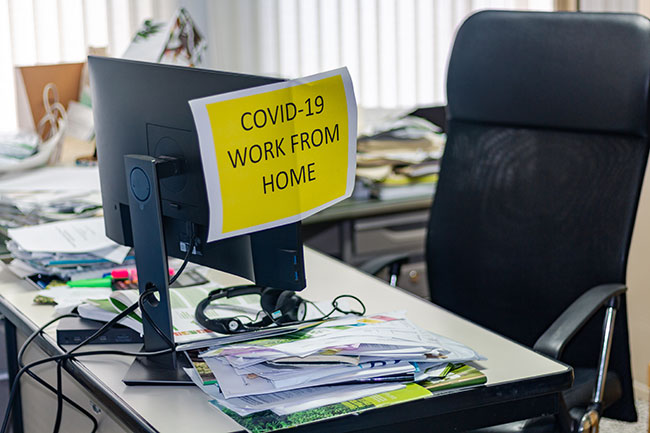

Columns/Blogs
Features
Culture
Working Remotely
Is remote work sustainable?
By Ashira Gobrin
 (RON/Adobe Stock)
(RON/Adobe Stock) Pre-COVID, many workplace leaders believed that we could not be effective working remotely — that we didn’t have the technology, processes and knowledge to make it happen.
However, the pandemic has proven that we can shift to remote work overnight, and for many organizations, it’s here to stay.
Yet, what’s being missed in conversations surrounding remote work is its significant long-term mental health fallout.
Surviving or thriving?
Like many organizations, an internal employee survey at Wave Financial Inc. found a consistent bell curve with roughly 20 per cent of staff thriving while working remotely. Not only is it a manageable scenario, it is preferred.

A majority of approximately 60 per cent said that while it isn’t a preferred situation, the pandemic has forced them to make it work, and even enjoy the flexibility work-from-home affords. When deemed safe, if offices were to open, they’d strongly consider going in two to three days a week.
And then there was approximately 20 per cent on the other side of that bell curve, who are genuinely suffering. This includes social extroverts whose “people meters” are empty — parents juggling between full-time jobs and young children kept away from schools; those dealing with depression and anxiety brought on by the quarantine; and others who may have had an existing mental-health issue due to previous trauma.
For this group, the routine of waking up early and going to an office — being surrounded by colleagues — helped manage their conditions. Now, they wake up and go to bed with their anxieties — in isolation.
With 80 per cent of their staff managing or even thriving working from home, most organizations will opt to keep their offices closed.

But when the same group was mapped on the scale of suffering, it was no longer a bell curve. This graph indicated a diagonal line declining to the right, showing 20 per cent of the people are carrying 80 per cent of the suffering.
In other words, we have a world designed for the 80 per cent of people who are thriving, but not for 20 per cent who are carrying 80 per cent of the suffering.
Best practices for remote work
For remote employment to work in the long run, these five best practices need to be top of mind for organizational leaders:
Notice the people who go unnoticed
In an office space, there are always those who quietly work in the corner.
Previously, managers could take the long way around to a meeting room and use the opportunity to catch up with the office introverts.
In a virtual environment, it’s easy to miss the introverts who may choose to keep quiet or their webcams switched off.
Making a conscious effort to check in with those you haven’t heard from during a video call is one of many ways to make the remote work environment more inclusive.
Gamify the onboarding experience
Onboarding presents new hires with mixed emotions.
On the one hand they are excited, eager to learn and please, and feel challenged. On the other hand, it can create anxiety.
Wave Financial Inc. decided to gamify the onboarding experience for new hires to overcome the negative anxiety. The onboarding package includes a game board that, in a fun and creative way, walks our new remote hires through the various steps of their first day. It ensures they are aware of and able to use the supports available to them.
Pay attention to the visual experience when hiring candidates
In the past, a candidate interview would entail a walk through the office space and physical meet and greets with potential or future colleagues. These would factor into a candidates’ consideration of whether they are a good fit or not.
Today, hiring is entirely digital and restricted to administrative tasks — a review of the digital job description and a Zoom call with company heads sums up the interaction.
This is not enough for a company to convey the emotive components of their culture. Showing video snippets of pre-COVID office life can make a big difference.
Do not assume what worked previously will work now
Practices that were good enough before, aren’t anymore.
When faced with a challenge, the key is to not just address the issue at hand for the moment, but to rethink it so the bar can be raised for the foreseeable future.
“Never waste a crisis” is an apt saying for these times. Simply modifying something when the opportunity exists to improve it, is a waste.
Reimagine compensation based on cost of living
Recently, Facebook announced their structured compensation model based on cost of living. They will downward adjust salaries for people moving out of expensive cities to smaller, cheaper ones.
But this needs to be rethought. By cutting salaries of those who have chosen to work remotely and moved out of the downtown core into suburbs due to affordability, managers are conveying that their skills are not enough to create value. This is a complex issue and needs to be handled with fairness and integrity.
The upshot is that the pandemic has opened the HR world up to top talent that is accessible beyond the daily commute. But long-term engagement of employees becomes a bigger issue.
We can be energized during a meeting; however, in a Zoom era, the second a meeting ends, the energy leaves the room, too. The visual engagement does not move beyond the screen.
And yet, human interaction prospers when the energy lingers past the moment. For remote work to be sustainable, employee engagement needs to be reimagined.
Leaders need to prioritize how they can make their remote workers feel emotionally supported and engaged, creating high-trust, outcome-managed environments that allow employees more autonomy to continue making choices on where they work and how they work.
Culture is at the core of it.
 Ashira Gobrin is the chief people officer at Wave Financial Inc. in Toronto. She is a member of the Strategic Capability Network’s CHRO Peer Forums.
Ashira Gobrin is the chief people officer at Wave Financial Inc. in Toronto. She is a member of the Strategic Capability Network’s CHRO Peer Forums.
Print this page